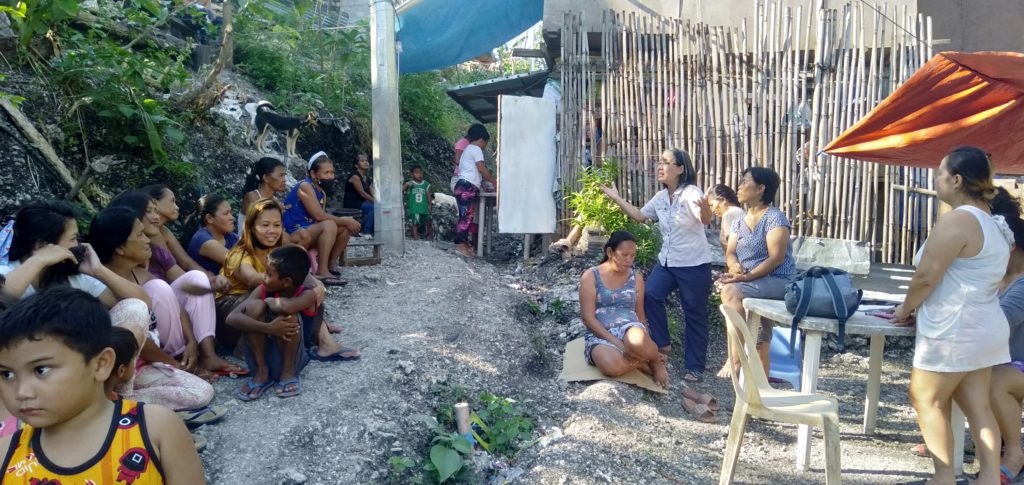The second level of basic health skills training for15 community health workers of PurokTambis, Barangay Umapad, Mandaue City was conducted last November 9,10, 11, 15, 16, 2016.
The training is in line with the ongoing project of the VPHCS, “Building community-based health programs to promote health and prevent disease in urban poor communities in Cebu” supported by the Committee of German Doctors for Developing Countries.
The training started by a sharing among the participants how it had been since their last training, how they have applied the knowledge and skills that they got.
The content of the training was based on the BHST curriculum of the Council for Health and Development (CHD), a national consortium of health institutions working to build CBHPs, of which the VPHCS is a member.
The first one a half days were allotted to discussion of the human anatomy and physiology. The different human body systems were expounded through videos downloaded from the www.youtube.com, hand-outs, powerpoints and lectures by VPHCS staff. They included the skin, skeletal system, muscular system, nervous system, respiratory system, cardiovascular system, digestive system, excretory system, reproductive system, and immune system. In order to make the learning process easy for the participants, the discussion was very simplified and in a manner that they can imagine and understand well the parts of the body and their functions. well Although the videos were in English, they were actually made for the layman and not for medical people.
The second topic was taking history and physical examination. History taking included asking questions on the general information about the patient, then on the illness felt by the patient such as cough, colds, fever, headache, body pains, including the time of onset of the illness, its duration, progression of the illness, and associated symptoms, what remedies had been done by the patient.
Physical examination included examining the different parts of the patient using the five senses and the hands. These included examining the skin, the head, face, eyes, ears, nose, mouth, throat, neck, chest for the heart, back for the lungs, abdomen for the stomach, intestines, liver, kidneys, the reproductive organs, the arms and the legs. The methods of examination were very simplified. Common abnormalities in each system which are signs of disease were illustrated and explained using videos and demonstrations by the lecturers. However, we do not expect that the participants would be able to comprehend them right away and we explained to them that we will teach them more when they actually see patients in their communities and in the rolling clinics.
The third topic was using medicines correctly and some common medicines. It was pointed out that we should use medicines in the most effective ways, that medicines must be used only when necessary, and that CHWs must educate the people about the correct and incorrect use of medicine.
The next topic was first aid in common emergencies that can occur in the household. First aid is the care given a sick or injured person before the services of a doctor can be obtained. These emergencies include wounds, nosebleeding, burns, poisoning, simple fainting, convulsions, heat stroke, heart attack, dog, cat and snake bites, foreign bodies in the ears, eyes, nose, and throat, and sprains. Each emergency and the appropriate first aid were demonstrated through videos downloaded from the www.youtube.com and by the resource persons with the participants during the training.
The next topic was wound care. The different types of wound were illustrated followed by how to clean simple wounds using clean water then antiseptic solution, bandage them and take care of the wounds until they heal. Complicated wounds that need to be attended to by doctors or nurses were also illustrated. The lecture was then followed by demonstration of wound care by the participants using first aid kits that were provided to them. Five sets of kits were distributed, each consisting of sterile bandages, surgical forceps and scissors, plasters, antiseptic solution, cotton, and elastic bandages.
The next topic was patient’s record keeping. This meant that each CHW should ensure that each patient that he sees has an individual record on paper. Instead of using pieces of paper, the CHW would use a notebook, with four pages allotted to a patient. Every time a patient is checked up, the CHW would write down his name, age, date of check-up, complaint, diagnosis of illness, service provided. If the same patient goes for check-up again, this entry would follow the previous entry on the same page or the following page. Since the CHWs had been doing this already after the first BHST, we went over their notebooks and instructed them if they were not done properly.
The final topic of the training was health campaigns. In this case, the ongoing campaigns that the CHWs started, that is, on prevention and control of hypertension and nutrition program for malnourished children were discussed and deepened on how to better improve them.
The training ended with an evaluation of the training.



